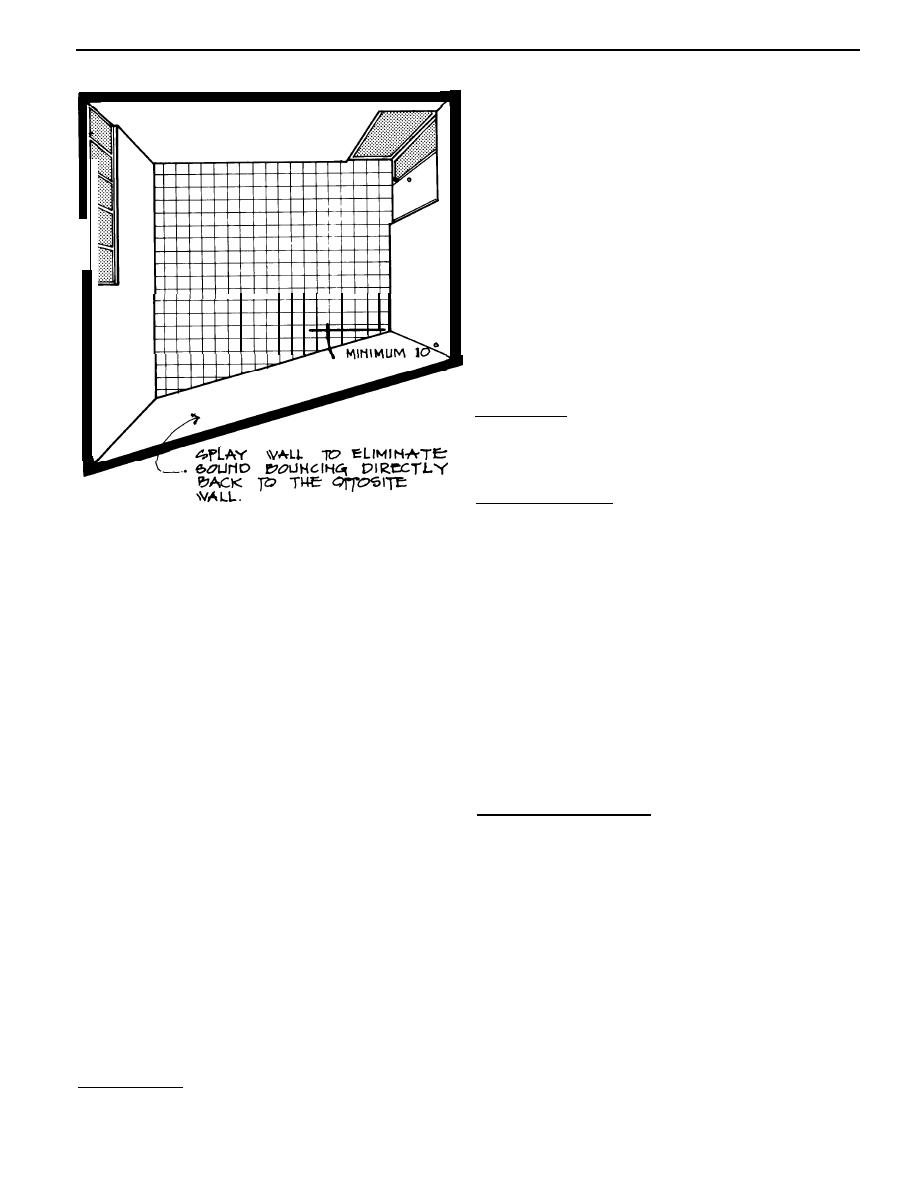
DG-1110-3-119
Design Guide: Band Training Facilities
March 1983
General Design Programming
4270.1-M, TM 5-785, and TM 5-810-1. Specific require-
ments for band facilities include:
q Air conditioning should be provided for temperature and
humidity control on a year-round basis. Many of the
musical instruments are very expensive and highly sensi-
tive to changes in humidity and temperature, and must
be protected.
q Mechanical systems must be designed to minimize noise
generation and transmission, and disruption of band prac-
tice activities. See Paragraph 5-3 for specific criteria
and practical approaches for acoustically acceptable
design of mechanical systems in relationship to music
spaces.
q Inside desiqn temperatures shall be as follows: Winter
inside design temperature is 68F; fresh air will be limited
to 10 cfm per person, for energy conservation purposes.
Summer inside design temperature is limited to 78F. Humid-
ity levels shall remain within the range of 40% to 50%.
B. Plumbing. Plumbing, water supply and sewer systems
will be in accordance with TM 5-810-5 and 6, TM 5-814-1,
and DOD 4270.1-M. Conservation of water shall be a
consideration of prime importance in the design of the facility,
as discussed in DOD 4270.1-M.
C. Fire and Safety. General safety and fire protection
measures for the Band Training Facility will conform to DOD
Figure 3-16. Elimination of Flutter with a Splayed Wall
4270-1.M, the requirements of the National Fire Protec-
tion Association (NFPA), and applicable sections of TM 5-812-
1 and TM 5-813-6.
age diffusion. For this, within the limits of practicality and
Sprinkler systems and wet-type fire extinguishers are not
consistent with the previous recommendations, the sug-
recommended, because they may cause damage to musi-
gested provisions are: irregular, non-rectangular room
cal instruments, equipment, sheet music and other library
shapes; small-scale splays and bumps on large, otherwise
materials. Dry-type portable fire extinguishers should
plain surfaces (but still measuring feet, not inches, in width
be provided, particularly in locations adjacent to the
and depth); and distribution of sound-absorbing finishes
Library, Audio Control Booth, Individual Instrument Lockers,
throughout the room, rather than their concentration on
and Unit Supply/Storage Area.
one or two surfaces.
Smoke alarms should be provided in all areas. The fire alarm
At least some of the sound-absorbing materials should
system should provide flashing lights as well as audible
be furred-out or, in the case of ceilings, suspended. The
alarms in sound-isolated areas, including all rehearsal and
airspace thus created behind the material will help absorb
practice rooms. Location of detectors and alarms must
low-frequency sound and reduce boom. This must be taken
comply with NFPA 101, Section 7-6. The type of system
into account when determining finished room dimensions
shall comply with Section 26-4.3.5.
and ceiling heights.
D. Electrical and Lighting. Electrical design will conform
For wall absorption in the larger music rooms, adjusta-
to DOD 4270.1-M and TM 5-811-1 through 4. Lighting lev-
ble drapes on tracks are recommended. This would allow
els will conform to IES standards and DOD 4270.1-M.
refIective surfaces to be covered or uncovered to reduce
Systems characteristics will be selected to provide for the
or increase "liveness". Such flexibility is likely to be appre-
most efficient and economical distribution of energy, in
ciated by bandmasters, to suit their personal preferences,
accordance with DOD 4270.1-M.
as well as by the various ensembles, to suit their musical
Emergency power will conform to the requirements of
styles.
NFPA Standard NO. 101 for exit and emergency lighting
systems. Auxiliary power requirements for fire alarms,
exit lights and emergency lighting systems will be provided
3-6 Environmental Systems
in accordance with appropriate NFPA Standard.
Design
q Convenience outlets shall be provided in all music prac-
tice areas in the following suggested quantities: Small
Individual Practice Rooms-2 duplex outlets; Large individ-
The following environmental systems considerations apply
ual Practice Room-3 duplex outlets; Small Group Prac-
to all the spaces within the Band Training Facility.
tice Rooms-6; Large Group Practice Room and Main
A. Mechanical. Heating, ventilating and air conditioning
Rehearsal Room-8 on the walls and four evenly distri-
buted on the floor.
systems will conform to the applicable portions of DOD
3-15


 Previous Page
Previous Page
